REWIND FEATURE: HALLOWEEN
Welcome to this 2002 Rewind Special in which Rewind Site Manager Adrian Busby takes a look at one of the most influential horror films of all time, Halloween, and the series it spawned. Please note that this feature contains details of a number of plot points but no spoilers. To access comparisons for all of the films, just click on the relevant logo for each one.

| Budget: $300,000 | - US Gross: $47m | - US Premiere: 25th October 1978 |
"I met him 15 years ago. I was told there was nothing left. No reason, no conscience, no understanding... and even the most rudimentary sense of life and death, of good or evil, right or wrong. I met this six year old child with this blank, pale, emotionless face and the blackest eyes...the Devil's eyes. I spent eight years trying to reach him and then another seven trying to keep him locked up because I realised that what was living behind that boy's eyes was purely and simply evil." - Dr Loomis, Halloween

Halloween is one of the best horror films of all time and John Carpenter is certainly a master of the genre. His use of the widescreen format creates much of the suspense and tension of the film. By skilfully placing action at the far edge of the picture, he fully encompasses and involves the audience and the method makes the scares all the more sudden and unexpected. He uses audio 'stings' throughout the film to heighten the moment and enhance the experience. Carpenter also makes terrific use of POV (Point Of View) Panaglide shots, especially in the opening sequence which, although commonly thought of as one continual shot, is three separate shots with two very clever cuts within the scene. The audience knows someone is watching the house and becomes that person. They also become guilty of murder as the scene progresses and when it ends, the shocking revelation is even more dramatic.
An independent, low budget ($300,000) film, it was made in the Spring of 1978. The crew hand painted leaves brown to make it look like October, scattering them on the ground to film and then picking them all up to re-use them at the next location. Filming finished on-time and it premiered on 25th October 1978 in Carpenter's home town of Bowling Green, Kentucky. The reviews were negative - many critics hated it. However, word of mouth and eventual critical praise saw the film become more popular every week. The distributors realised they had a hit and immediately pulled it from every cinema. Mounting a huge marketing campaign, they re-released the film the following year and it became the most successful independent film of all time. When that title was eventually lost in 1990 (to the mass marketed and hyped Teenage Mutant Ninja Turtles!) Halloween had grossed $80 million in the US alone.
The reason for the success can be largely attributed to John Carpenter's chilling score. In fact, when the film was shown to a number of studio executives before the addition of the score, it was rejected as being not at all scary. This fantastic score is credited on the film to The Bowling Green Philharmonic Orchestra. However, this is a pseudonym for John Carpenter and a group of friends!
The film credits also distinguish between the adult Michael Myers (played by Tony Moran) and The Shape (played by Nick Castle). They are the same character and Tony only appears at the end of the film when Laurie rips off Michael's mask - which was actually a modified mask of William Shatner (Captain Kirk in the Star Trek series)!
The film launched the career of a relatively unknown young actress, Jamie Lee Curtis. Her father is Tony Curtis and her mother is Janet Leigh, who was famous at that point for starring as the ill-fated Marion Crane in Hitchcock's Psycho.
Carpenter paid tribute to Hitchcock by naming the character played by Donald Pleasence, Sam Loomis, after Marion's lover in Psycho. The nurse assigned with the transfer of Michael at the beginning of Halloween is called Marion. Carpenter also 'honoured' the London Distributor of his previous film Assault On Precinct 13 by naming the Michael Myers character after him.
While filming the sequel (see below for further details) the original was set to be shown on TV and the rights were purchased by NBC. However, their Standards and Practices department required numerous edits to the film but, because they also needed to fill a 2 hour slot, Carpenter agreed to shoot a number of new scenes to lengthen the film and hence the TV version is different to the original theatrical version. (Anchor Bay must be making a fortune with their multiple DVD versions!). The additional scenes are as follows:
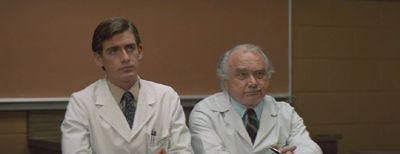
Loomis meets with sanatarium psychiatrists to discuss Michael and attempt to persuade them to move him to a maximum security institution
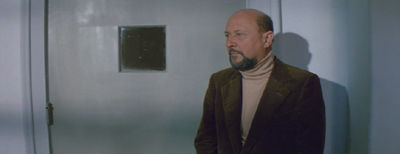
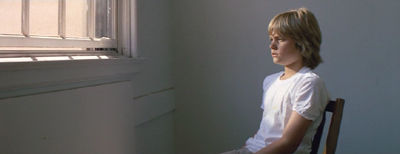
Loomis visits Michael as a child in the institution (Parts of this and the next scene were used in Laurie's dream sequence in Halloween 2 to suggest the fact that Laurie is Michael's sister. A point that is revealed later in the sequel when Marion and Sam discuss the previously unreleased case notes. I personally think adding it to the original film spoils the mystery, without it we don't know why Michael is stalking Laurie and that adds to the intrigue and suspense)
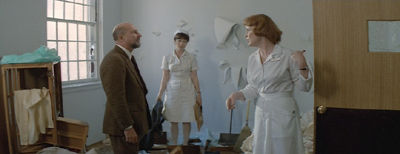
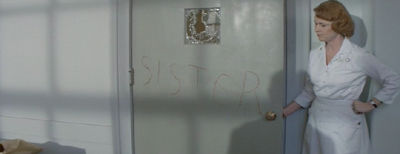
Loomis is called back to the institution after Michael has escpaed and discovers the word 'Sister' scrawled in blood on the cell door
Linda visits Laurie after school to borrow some clothes. (This scene had to be shot with Laurie wearing a towel on her head as if she had just had a shower because her hairstyle was now different to that of the original film)

| Budget: | unknown |
| US Gross: | $25.5m |
| US Premiere: | 30th October 1981 |
"I shot him 6 times! I shot him in the heart-but... HE'S NOT HUMAN!" - Dr Sam Loomis

Such was the success of Halloween that a sequel was put into production and Carpenter was persuaded to return as Writer/Producer, along with Debra Hill (the Co-Writer/Producer of the original film), but Carpenter didn't want to re-hash the original. He decided to develop the 'relationship' between Laurie and Michael, and it was originally intended that the film would be based around Laurie living in an apartment block, but it ended up following straight on from the first film and the Haddonfield Memorial Hospital became the film's focal location. Myers continues to stalk Laurie and eventually tracks her down to the hospital.
Director Rick Rosenthal does a good job with the film but it just isn't Carpenter. Fortunately, the classic Halloween score remains (albeit in a slightly 'updated' way). However, throughout the majority of the film, the score merely compliments rather than enhances the experience.
The film briefly introduces a 'cult' narrative, when Dr Loomis discovers references to Samhain - which he explains means Lord Of The Dead - a theme that wouldn't appear again until the 6th film - Halloween: The Curse of Michael Myers.
A significantly different version has been shown on US TV on a number of occasions which includes a number of extended scenes and an alternate ending where a member of the hospital staff survives.

| Budget: | $2.5m |
| US Gross: | $14.4m |
| US Premiere: | 22nd October 1982 |
"You don't really know much about Halloween. You thought no further than the strange custom of having your children wear masks and go out begging for candy." - Conal Cochran

Contractually obligated to be involved in 2 sequels, Carpenter decided to move away from the Michael Myers story and the result was this totally unrelated sequel which doesn't even feature Myers! Instead it involves a maniacal toy-maker who plans the ultimate 'joke on the kids' by marketing unique, 'interactive' Halloween masks. It explores the legends and myths of Halloween and as a film in its own right, stands up rather well, but fans of the series were disappointed by the lack of Myers and the series, eventually returned to form some 6 years later.

| Budget: | $5m |
| US Gross: | $17.7m |
| US Premiere: | 21st October 1988 |
"You talk about him as if he were a human being. That part of him died years ago." - Dr Sam Loomis

The series returns to the Michael Myers' story. On a routine transfer Michael learns that he has a niece (Jamie) who was adopted by the Caruthers family following Laurie's death in a car accident a number of years ago.
By now, the series has become more like the traditional 80's 'stalk and slash' formula with dislikeable characters only being introduced so that they can be slain later in the film. It's good that the 'family' theme has been kept which at least gives Myers a reason for keeping up the death count.
Alan Howarth continues to make use of the Halloween theme and score, but the film also includes rock tracks, something else that became traditional in late 80's horror films.
By far the best part of the film is the 'shock' ending. Unfortunately though, the revelation and suggested future story is forgotten in the next sequel.

| Budget: | $5m |
| US Gross: | $11.6m |
| US Premiere: | 13th October 1989 |
"Michael? It will destroy you too, one day, Michael! This rage which drives you. You think if you kill them all it will go away? It won't! You have to fight it!" - Dr Sam Loomis

One year later, Michael continues his quest to destroy his only living relative Jamie in what I consider to be the worst of the sequels. The narrative is the same 'stalk and slash' theme from the previous film and uses the same focal location as the 2nd film - Jamie Lloyd is in a children's hospital here, whereas Laurie Strode was in a hospital in Halloween 2. The exception being that Jamie now has a telepathic 'link' with Myers and can sense his actions and whereabouts. And the goon police are a real mistake!
It does however, begin the cult narrative which is heavily utilised in the following film but unfortunately, does little to explain it's meaning in this one!

| Budget: | $5m |
| US Gross: | $15.1m |
| US Premiere: | 29th September 1995 |
"I knew what he was, but I never knew why." - Dr Sam Loomis

This is a brave attempt to do something different with the series (rather than simply re-hash the now tired format of numbers 4 and 5). This deals with the origins of Halloween, the 'Thorn' occult and attempts some reasoning behind Myers escapades. Jamie is pregnant and when she gives birth and escapes the occult, Michael is sent after her. She is caught and killed but the baby survives and Michael's quest becomes a search for the child. Tommy (one of the children in the original film) returns to the series and it's revealed that he's been analysing Michael's behaviour since 1978. The other Strode family are also introduced - the father being the uncle of Laurie Strode. Incidentally, the parents are named John and Debra (after the original creators?).
Like the 2nd film, there's a significantly different version of this film, commonly known as The Producer's Cut which not only adds scenes but completely changes the development and fate of a number of characters and also explains the ending of the previous film in the series.

| Budget: | $17m |
| US Gross: | $55m |
| US Premiere: | 5th August 1998 |
"We've got a psychotic serial killer in the family who loves to butcher people on Halloween." - John Tate

Halloween H20 goes back to the end of Halloween 2, ignoring the subsequent sequels, and details what has happened to Laurie Strode in the 20 years that have elapsed since the events of the original.
Psycho was honoured again. Janet Leigh played Jamie Lee Curtis' secretary Marion in the film. (Look out for her comments about the girl's shower being blocked and the subtle use of Psycho's score when Marion is leaving the school in a very familiar car). In a tribute to a tribute, Kevin Williamson (a fan of Halloween himself) named one of his characters in Scream after Dr Loomis (Billy Loomis).
Although all the previous sequels had made a profit, this became the most profitable sequel of the series. A point which the producers probably have the Scream series to thank for.

| Budget: | $15m |
| US Gross: | $30m (as at 15th September 2002) |
| US Premiere: | 12th July 2002 |
"I'll see you in hell Michael!" - Laurie Strode

This continues the 'alternate' timeline from Halloween H20 which suggest that Michael was 'not around' between 1978 and 1998. The film is due for UK theatrical release on 25th October 2002 so I'll leave any further details for a future update of this article.
I highly recommend Halloween. Not only to horror fans but to those that enjoy a good thriller as well. And as for the squeamish, don't worry! As in all of Hitchcock's classics - SUGGESTION (NOT BLOOD AND GUTS) is the key to a REALLY good horror.
I hope you've found this article interesting and if it's inspired you to watch the series for the first time then that's even better. I'll leave you with these thoughts...
Black cats and goblins and broomsticks and ghosts,
Covens of witches with all of their hosts,
You may think they'd scare me, you're probably right,
Black cats and goblins on Halloween night.
TRICK OR TREAT!
LINKS
Picture Sources:
All material on this page is copyright of Adrian Busby and Rewind @ www.dvdcompare.net. No material, in whole or in part, can be copied or reproduced in any other publication, either online or offline, without prior written permission from the aforementioned people.

